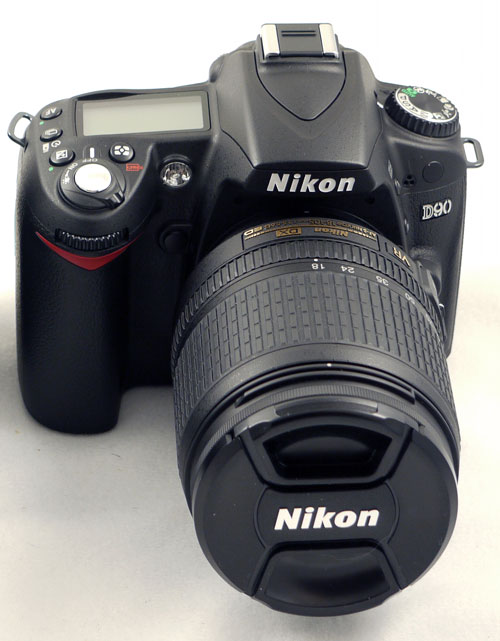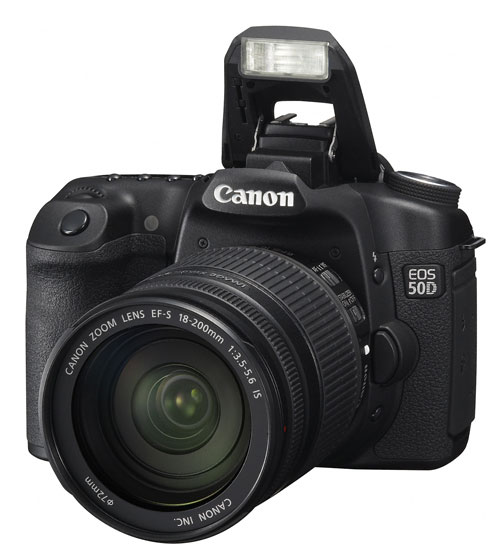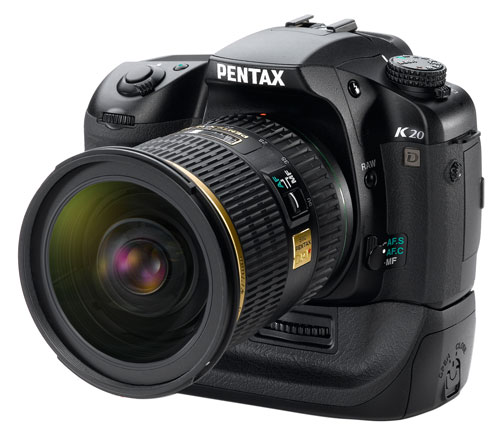Digital Cameras for the Holidays
by Wesley Fink on November 27, 2008 12:00 AM EST- Posted in
- Digital Camera
Prosumer Picks
Photo hobbyists usually have an investment in a particular lens line and that influences their buying decision. It also seems emotions run high among photography hobbyists, so any hard recommendation in the prosumer area invites a stoning from fans of other systems. However, we like to think we are objective and some recent introductions have reshaped value in the prosumer space.

Nikon pulled out all the stops with the new D90. It basically features the same 12.3MP CMOS sensor as the Sony A700 and Nikon D300 with updated image processing. However, the starting price is $999 and not $1395 or $1795. That will deliver a lot of value to the Prosumer segment.
Nikon lavished most of the features of the D300 on the new D90, including the 3" 920,000 pixel hi-res LCD used on the D300 and Sony A700. The only major exception is the 51-point AF module unique to the D300 and A700/D3; the D90 merely has a fast 11-point AF. Also new to the D90 and missing from the D80 are two flavors of Live View and Auto Sensor Cleaning. Image processing has been borrowed almost in total from the D300 with both cameras now featuring Nikon's Scene Recognition System, and D-Lighting for expanded dynamic range. Continuous shooting speed also jumps to 4.5 FPS from the 3 FPS of the D80.
Nikon also introduced a new standard lens with the D90 in the 18-105mm VR AF-S. The new normal zoom is arguably the best image quality of Nikon's current selection of crop-sensor normal lenses. Last, but not least to some buyers, the D90 features a Movie Mode - a first in this class. Unfortunately, auto-focus is not active in the movie mode so this feature was of limited use in our testing. However, it will be a nice option for shooting subjects that stay in place and don't move much - like still life. In total the D90 is a great value in the prosumer class and hard to beat.

The new Canon 50D moves Canon to the top of the class in crop-sensor resolution again with a 15.1MP sensor and an incredibly wide range of ISO adjustments to ISO 12800. However, resolution tests show about the same results as the 12.3MP Nikon D90, D300, and Sony A700. Noise also increases a bit with the more densely packed sensor, resulting in no real gain in noise-reduction at the top, and a slight reduction in dynamic range compared to the competition.
The 50D does feature a 920,000 dot LCD, which is a significant improvement over the 40D 3" low-res screen. Image processing is also sped up with a Digic 4 processor. While the list price is $1395 for body only, the 50D is currently selling for around $1200.

Canon continued the 40D in their product line and the 10.1MP 40D has become a super value in this class. If you want a top advanced amateur camera but price is a concern, you can find the 40D selling for $799 to $849, which is an excellent value.

Another great value in prosumer cameras is the rugged, pro-sealed Pentax K20D, which is now selling in the $750 to $800 price range. Resolution is a very high 14.6 megapixels, but noise and color shifts can become an issue at higher ISOs. AF speed is not the fastest and neither are continuous frame rates, but as a high resolution photo tool with a huge offering of Pentax AF lenses the K20D is an outstanding value.
If you want a more rugged pro Nikon body, 51-point AF, and a few more features - at a higher price - the Nikon D300 is a good choice. The Sony A700 uses the same Sony 12.3MP sensor as the D300, and it is very fast and capable. Sony has been running a $300 off special pricing recently, presumably because a replacement model is expected at PMA early next year. The A700 lacks any kind of Live View if that feature matters to you, but Live View is pretty basic and very slow in most of the DSLR competition so it is more a checklist feature than truly useful.
If you are an Olympus fan, you will need to wait for a couple of months. Olympus has announced the new 12MP E30 that brings most of the great E3 features, including its super fast AF module, down to a lower prosumer price point. The E30 will not ship until early 2009.










41 Comments
View All Comments
Wesley Fink - Friday, November 28, 2008 - link
We;ve added mention of the Pentax K20D as a great value at $750 to $800 in the Prosumer category. It is not, however, without its probelms, as is true of any camera, and the price has dropped from $1295 to $750 in pretty short order. Its an outstnding value if it fits your needs and the way you shoot.ubiloo - Friday, November 28, 2008 - link
Sorry, I meant 'for at least €100 less'computerfarmer - Thursday, November 27, 2008 - link
If I were to choose.......from this article.Point and shoot:
Panasonic Lumix DMC-L8 for quality, Canon Powershot A590 IS best for the money.
Super Zoom:
Panasonic Lumix LMC-TZ5
Entry Interchangeable Lens:
Canon XSi or XS and Panasonic G1
At this level, all make decent products....hard to choose.
Prosumer:
Nikon D90 or Canon 50D ....hard to choose.
Full-Frame:
Nikon D700 or Canon 5D Mark II
I am about to enter the "Entry Interchangeable Lens" category, perhaps in March or April. I have gone from point and shoot to superzoom. Panisonic FZ8 is camera I have now. It is so much better than the point and shoot. But the cost to go up to the next level is quite substantial. With a kit lens, I will not get the zoom I am accustomed too. The macro part I am unsure of. Then there is the flash. The number one reason for upgrading is the quality of photograph. The question I have is, if I wanted to print 13x19 inch photos, what camera and lens would do the best job for, Portraits, Birds, Indoors....
Example: If I purchased a Canon Rebel XSi; what else would I need to get the most out of this camera(general use). I am thinking the camera with the kit lens, plus a 200mm zoom lens, a macro lens, a flash(wireless would be nice), a good tripod. how much would this cost me?
This article gave a good overall view.....Thank You
strikeback03 - Monday, December 1, 2008 - link
Unless the birds are very tame, 200mm isn't very long. A friend of mine has the XTi with 18-55IS/55-250IS combo though and is very happy with them for general use. The 55-250IS is not that expensive, B&H has a kit with XSi/18-55IS/55-250IS for $708. The 100/2.8 Macro is a good macro lens and also very usable for tighter portraits, runs around $450. No Canon bodies offer wireless flash control in-body, so the flash itself ranges from $200-400 depending on power and features, and if you want wireless you either need remote triggers and external metering, or a ST-E2 wireless transmitter. Tripods are highly dependent on what you want and need, but guessing at least $100 is pretty safe.Note that for some items (lenses, flash) you can sometimes find third-party alternatives which work as well for your needs for less money.
haplo602 - Friday, November 28, 2008 - link
have a look on ebay ...I don't know the canon line of lenses, but something similar to the AF-S DX NIKKOR 18-105mm f/3.5-5.6G ED VR will make a good all-around starter lens.
Maxington - Thursday, November 27, 2008 - link
The G1 is revolutionary alright, its a camera that does away with the mirror box and optical viewfinder, without actually being any smaller than standard DSLRs!Why is this article have such a huge positive bias towards it? It should be applauded for actually trying, but totally dismissed until, like the rest of the 4/3rds range, it actually delivers on making a camera small. How you can recommend it whatsoever is beyond me.
Hell, Pentax have a far smaller setup, with the K2000/Km body, and their pancake lens range. And a better performing sensor with a bigger lens range to boot.
Speaking of Pentax, why were no Pentax cameras recommended? They are far better value for money than Nikon/Canon, though Sony camera bodies are probably the best value, pity their lenses are ridiculously priced.
Wesley Fink - Friday, November 28, 2008 - link
The G1 is a great deal smaller overall than any DSLR we have tested, but it also has many other features going for it, like the superb 3 inch tilt-and swivel hi-res LCD and the first EVF we could actually live with. It also breaks new ground in Live View AF.We agree the Pentax K20D is a great value at $750 to $800, and mention of the K20D has been added. It should also be mentioned that the price of the K20D has declined from $1295 to $750 in pretty short time. The pro-type sealing and 14.6 megapixel sensor are top of the class, but the high ISO noise, inconsistent color at high ISO, slow AF, and slow continuous frame-rates detract from the top-notch features.
gaston1 - Friday, November 28, 2008 - link
Thank you for adding K20D to the list. I agree about the AF being slower than the competition. High ISO noise, not really, I'd say it's in line with other APS-C cameras in its range, although Pentax has taken a different approach, producing grainier pictures at high ISO but preserving much more detail than the others (and can be cleaned very easily through software if one chooses to). ISO 1600 is very useable, 3200 is sort of equivalent to the K10D's 1600, not that clean but useful when needed, and the 6400 is not that useable, in my opinion. We must also not forget that most reviews (comparing jpegs) will have Pentax tested on its default setting with noise reduction off while it kicks in by default on other cameras once you start using higher ISO settings. Canon's ISO 12800 hardly contains any detail at all, and in my opinion is just there for marketing purposes.As far as value goes, Pentax shines when you start considering lenses. I strongly considered going for the Nikon D700 or even waiting for the Canon 5D mkII, both great cameras for low light (or landscape) photography. But after researching the lenses that I would need, the system price was quickly stretching far beyond my amateur's budget (although still a bargain if you're a pro and need the features). I even briefly considered Sony's A900 but had a similar issue with the cost of lenses.
strikeback03 - Monday, December 1, 2008 - link
I don't really see the advantage in Pentax lens prices that you mention. Seems like they have dropped some, as a year ago I initially recommended a K10D with 16-50 2.8 to a friend, expecting the 16-50 to be around $500. I was shocked to see it was around $900 at the time. At least now it is more reasonable. Checking other similar lenses they seem to be mostly in line with Canon/Nikon, with some deals (50/1.4 for $200) and some more expensive (the 77/1.8 vs 85/1.8 from others).Maxington - Friday, November 28, 2008 - link
Echoing what gaston1 said, thanks for adding the K20D to the list.Also echoing the high iso comment, Pentax has higher noise due to it retaining detail and not smearing it away like Nikon/Canon do. I'd rather keep the detail and post-process it later, with much better tools, than let the camera do it.
http://www.dpreview.com/reviews/pentaxk20d/page18....">http://www.dpreview.com/reviews/pentaxk20d/page18....
Look at the mush the others turn into.
I'm still not convinced the minor size drop the Panasonic G1 has makes it worthwhile. (It's about half a cm shorter than the Pentax Km, and about 2cm thinner) It's not small enough to drop into "pocket" range, especially with the lack of pancake lenses, thus any size benefit it has is pretty much pointless. It's still a DSLR to carry. When they get it down to being like a rangefinder, then it'll be worth looking at.
I do like the back lcd and the slick contrast af though.